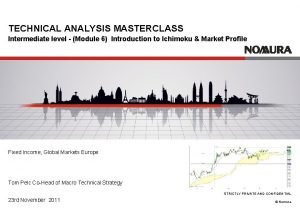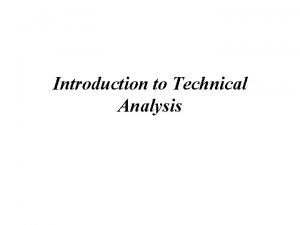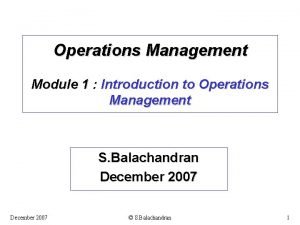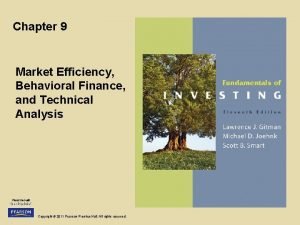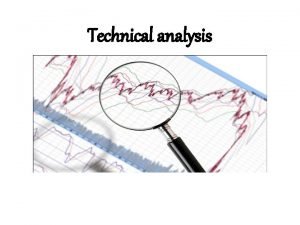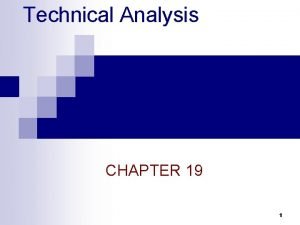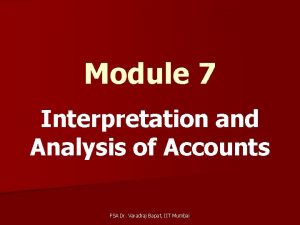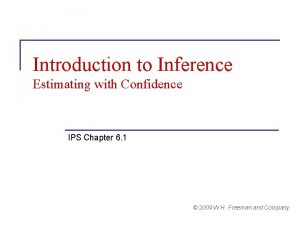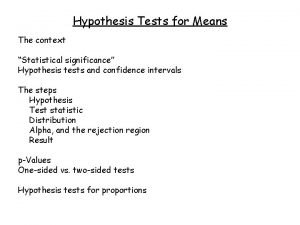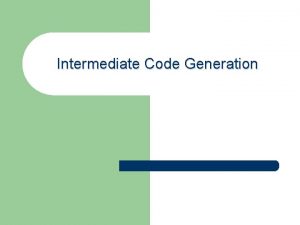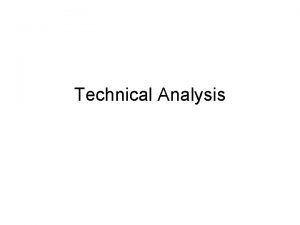TECHNICAL ANALYSIS MASTERCLASS Intermediate level Module 6 Introduction






















































- Slides: 54

TECHNICAL ANALYSIS MASTERCLASS Intermediate level - (Module 6) Introduction to Ichimoku & Market Profile Fixed Income, Global Markets Europe Tom Pelc Co-Head of Macro Technical Strategy STRICTLY PRIVATE AND CONFIDENTIAL 23 rd November 2011 © Nomura

Course Contents Module 1 Introduction to Technical Analysis – support/resistance, trend-lines, gaps, Fibonacci techniques, projections, extensions, time zones, Fibonacci arcs, how to use a Lucas Table Module 2 Western chart patterns, introduction to Dow theory, gaps, reversal periods Module 3 Japanese Candlestick charting Module 4 Moving Averages and Bollinger bands Module 5 Momentum Oscillators Module 6 Ichimoku charting and Market Profile concepts and interpretation Module 7 Elliott Wave introduction to rules and application Module 8 Cycles – natural, financial and esoteric approaches to forecasting including astrology FINANCIAL MARKETS

A brief look back at history 400 mln yrs - (Paleozoic era) – the sponge, starfish and chambered nautilus. 50, 000 BC - Early stone age begins (fire possibly discovered) 15, 000 BC - Works of art appear 4, 700 BC - Possibly beginning of the Babylonian calendar 4, 241 BC - Egyptian calendar was introduced. 4, 000 BC - Pyramid of Giza, interesting mathematical/astronomical traits 3, 113 BC - Age of Pisces 13 th Aug 3113 BC to end 21 st Dec 2012 1, 832 BC - Rhind papyrus (geometry of Triangles), but no concept of zero 1, 500 BC - Oldest Egyptian sundial. 325 -265 BC - Euclid “ 13 Books of the elements” 300 AD - Concept of Zero from Indian and Mayan cultures 552 AD - Buddhism introduced in Japan FINANCIAL MARKETS

A brief look back at history 1202 - ‘Liber Abaci’ is published by Leonardo Pisano (Fibonacci) 1228 - ‘Liber Abaci’ is edited and 4 other books written by Pisano 1345 - Peak of worlds biggest financial crash (Bardi & Peruzzi) 1440 - Invention of movable type – led to textbooks becoming available 1509 - Luca Pacioli ‘the divine proportion’ illustrations by Leonardo Da Vinci 1611 - J. Kepler arrives at Fibonacci sequence independently 1710 - First rice exchange opens using empty coupons at Dojima, Japan 1803 - Munehisa Homma writings on his trading principles (b. 1724 d. 1803) 1868 - Japan changes from Wasan to Western style mathematics. 1902 - Dow dies - William P. Hamilton takes up principles, 27 years to write. 1938 - Monograph entitled The Wave Principle is published. (Elliott Wave) 1969 - Ichimoku becomes widely available by Hosoda 1987 - Peter Steidlemeyer publishes market profile charting techniques. FINANCIAL MARKETS

Introduction to Ichimoku – The History The term “Ichimoku” can be translated from Japanese as “instant view’ or “one glance”, “Kinko” is the equivalent of “equilibrium” or “balance” and “Hyo” means “chart”. Hence the full name “Ichimoku Kinko Hyo” actually means “one glance cloud chart” or more appropriately “Instant view of the balance chart”. Goichi Hosoda developed Ichimoku Kinko Hyo in the early Showa era (1926 -1989) and copyright is owned by Kabushiki Kaisha Hendou Souken. However, Hosoda, a Japanese newspaper writer, only published his findings in 1969 and from that point forward Ichimoku Kinko Hyo has become a permanent feature in Japanese trading rooms. FINANCIAL MARKETS

Introduction to Ichimoku The series of lines are very similar to moving averages and are based upon high and low prices. The two Senkou Span (leading) lines are pushed forward in time to represent past support and resistance – similar in concept to the idea that once established, support will continue to provide support until broken when it becomes resistance. The area between the two Senkou Span lines is shaded to make it look like a cloud. This “cloud” not only defines the trend, but acts as support and resistance for price. Cloud = Kumo FINANCIAL MARKETS

Ichimoku study = 5 lines are used 1. Tenkan-Sen or Conversion Line = (Highest High+ Lowest Low)/2, for the past p 1 periods (9) (similar to ma but uses high and low not closes measures the strength of the market) 2. Kijun-Sen or Base Line = (Highest High + Lowest Low)/2, for the past p 2 periods (26) (In general, the market trend is bullish when prices are above the base line) 3. Senkou Span A or Leading Span A = (Tenkan-sen+Kijun-Sen)/2, for the past p 2 periods (26) 4. Senkou Span B or Leading Span B = (Highest High + Lowest Low)/2, for the past p 3 periods, (52) plotted p 4 (26) periods ahead. 5. Chikou Line lagging line the most current closing price plotted 26 periods behind the optional By default p 1=9, p 2=26, p 3=52, p 4=26. Kumo, or cloud is the area between Senkou Span A and B. A Buy signal is when the Tenkan-Sen crosses Kijun-Sen from below. A Sell signal is when Tenkan-Sen crosses Kijun-Sen from above. Clouds play the role of support/resistance areas and help identify trends. When the price is above the clouds, the trend is bullish. When the price is below the clouds, the trend is bearish. FINANCIAL MARKETS

Tenkan - or Conversion Line - Daily EUR/USD (Highest High+ Lowest Low)/2, for the past p 1 periods) (9) (similar to ma but uses high and low not closes measures the strength of the market) TENKAN (Conversion Line) FINANCIAL MARKETS

Kijun-Sen or Base Line - Daily EUR/USD (Highest High + Lowest Low)/2, for the past p 2 periods (26) (In general, the market trend is bullish when prices are above the base line) TENKAN (Conversion line) A Sell signal is when Tenkan-Sen crosses Kijun-Sen from above. KIJUN (Base line) (prices indicate end of trend) breaking base line A Buy signal is when the Tenkan-Sen crosses Kijun-Sen from below. TENKAN (Conversion line) FINANCIAL MARKETS

SENKOU SPAN LINES SENKOU SPAN A - The average price of the conversion and base line values plotted as a number of periods in advance. The number of periods in the Lead & Lag Period field determines how far in advance the value is plotted. For example, if the value in the Lead & Lag Period field is 26 days, the Leading Span A line extends 25 days past the end date. (26 periods typically). SENKOU SPAN B - The average of the high and low prices for a past number of periods plotted in advance. The number of past periods is twice the number in the Lead & Lag Period field. The number of periods in the Lead & Lag Period field determines how far in advance the value is plotted. (52 periods typically). FINANCIAL MARKETS

Ichimoku – Span lines – EUR/USD Daily chart These lines are pushed forward to act as support and resistance KUMO/CLOUD SPAN B SPAN A Senkou Span A or Leading Span A = (Tenkan-sen+Kijun-Sen)/2, for the past p 2 periods (26) Senkou Span B or Leading Span B = (Highest High + Lowest Low)/2, for the past p 3 periods, (52) plotted p 4 (26) periods ahead. “KUMO”= “CLOUD” is distance between these 2 lines FINANCIAL MARKETS

4 lines together – EUR/USD Prices struggled to hold above the cloud Prices now below the base-line FINANCIAL MARKETS

EUR/USD – Chiku line Overall strength - Strength is shown to be with the sellers if the Chikou Span is below the current price. Strength is shown to be with the buyers when the opposite is true. (26 day lag of prices). CHIKU LINE FINANCIAL MARKETS

All together now for EUR/USD and some simple retracements Resistance at Chiku and retrace area FINANCIAL MARKETS

Historical context – for consideration Note that Ichimoku relies on only three different time periods in its calculations: 9, 26 and 52. Those periods stem from a history when the system was developed prior to WWII. Japanese financial markets used to be open for trading on Saturdays, meaning that the trading week was 6 days long. As a result, the number 9 represents a week and a half of trading; 26 equals the number of trading days in a typical month (30 minus four Sundays); and 52 equals two months of trading days. Japanese markets now trade only five days per week and 22 days in a typical month, so some practitioners of Ichimoku suggest revising the parameters to seven or eight, 22 and 44. 9 days = 1 ½ weeks trading 26 days = 30 days – 4 Sundays thus 1 month 52 days = 2 months FINANCIAL MARKETS

EUR/JPY – Daily chart Prices still way below the “Cloud” or “Kumo” at present. Chiku line failed above the Kijun line FINANCIAL MARKETS

GBP/PLN – Daily chart Strong trend here price action above all the lines so waiting for a signal of fatigue still FINANCIAL MARKETS

EUR/GBP – Daily chart what can you see? FINANCIAL MARKETS

S&P 500 – Daily chart what can you see? FINANCIAL MARKETS

Bund Z 1 – Daily chart what can you see? FINANCIAL MARKETS

Ichimoku summary - checklist Good for bigger trend plays when you want to figure out is the start of a potential big trend move. Used like a moving average oscillator so easy to follow. Quite often black box models have some derivation of the lines in their calculations. Keeps you in a trend when it is against you short term, by using the base line as support/stop loss trigger. -Strong signals - A strong buy signal occurs when the Tenkan-Sen crosses above the Kijun-Sen from below. A strong sell signal occurs when the opposite occurs. The signals must be above the Kumo. -Normal signals - A normal buy signal occurs when the Tenkan-Sen crosses above the Kijun-Sen from below. A normal sell signal occurs when the opposite occurs. The signals must be within the Kumo. -Weak signals - A weak buy signal occurs when the Tenkan-Sen crosses above the Kijun-Sen from below. A weak sell signal occurs when the opposite occurs. The signals must be below the Kumo. -Overall strength - Strength is shown to be with the sellers if the Chikou Span is below the current price. Strength is shown to be with the buyers when the opposite is true. -Support/resistance levels - Support and resistance levels are represented by the presence of the Kumo. If the price is entering the Kumo from below, then the price is at a resistance level. If the price is falling into the Kumo, then there is a support level. - Trends can be determined by simply looking at where the current price is in relation to the Kumo. If the price stays below the Kumo, then there is a downward trend (bearish). Alternatively, if the price stays above the Kumo, then there is an upward trend (bullish). FINANCIAL MARKETS

INTRODUCTION TO MARKET PROFILE CHARTING • Market profile (MP) uses the evolving market as its database rather than past market history. • MP is a present tense information source. • It looks for price distribution by using the bell curve. • MP does not try to predict the future based on the past, but tries to identify the underlying conditions of the current market’s movement for continuation or change. • Primarily it tries to organise chaotic, seemingly random market activity into meaningful, measurable data segments that can be captured, defined and then monitored. • MP uses the bell curve to this by organising the data. • Displays price, volume and time frame, on a single chart. FINANCIAL MARKETS

Market profile interpretation MP invented by J. P. Steidlmayer The underlying premise is that market players have different timeframes, and those with shorter timeframes are forced into action by price movement, while those with more time have more options. Therefore, not all market players are active at the same time. The more the market moves, the more these players become involved and the easier it becomes to trade. This leads to some observations: As prices go up, buying eventually diminishes, and vice-versa for a falling market. Trends continue until the last long-term buyer or seller executes their trade. FINANCIAL MARKETS

Market profile interpretation There are two types of activity: initiative and responsive. Initiative activity occurs when players buy at or above (or selling at or below) the red value line, which indicates an opinion on future direction. Responsive activity occurs within the value area. Market Picture divides the trading day into 30 -minute sessions for analysis. If you can figure out quickly enough which profile shape is forming on any given day, then within a few hours of the market's opening, you can reasonably infer where the markets may trade for the balance of the day. This is a huge advantage for those trading based on intraday movement, especially sell-side dealers, buy-side proprietary traders, and outright speculators. Day traders use this method to establish the market's balance and to look for price levels that bring players into the market. This is where prices have gone low enough to bring in longer-term buyers and high enough to attract long-term selling. Most day traders try to establish these levels in the first hour of the day. Those who follow the Steidlmayer method try to classify the day into 5 basic distribution profiles. But first some concepts… FINANCIAL MARKETS

The bell curve What does normal distribution mean? The normal distribution curve In statistics when you take a random sample of a population and measure them for height, you can draw a chart showing how many people are represented at each unit of height. A “normal distribution” would show a clustering of people around the average height with less and less people as you move towards the extremes. Very short people and very tall people are less frequent than people close to the average height. (The “mean”). The bell curve & standard deviation A plot of the number of people at each unit of height would show a bell shaped curve (a normal distribution), with 68% of the total sample within one standard deviation of the average height. 68 % A normal distribution, with the first 3 std’s in each direction -3 -2 -1 0 1 2 3 FINANCIAL MARKETS

Standard deviation calculation (a) Find the average of all the data points. 2+4+6+3+5 = 20 20/5= 4 (b) Sum all the squares of all the data points. 4+16+36+9+25 = 90 (c) Divide the sum of the squares of all nine data points (b) by the number of data points within the series. In this case we have five items of data. 90/5 = 18 Subtract the square of (a) from (c) 18 -16=2 The Square root of (d) is 1 standard deviation = 1. 414 FINANCIAL MARKETS

The bell curve and market profile In a market with good two-way trading, and where the market has established a range, the same type of price distribution will be seen. A Market profile chart Price Most activity will occur towards the middle of the range with the extreme prices seeing little or no activity and volume. When price action is plotted using MP, the same bell shape curve distribution will be seen with the minor difference that the price will be on the vertical axis whereas normally in a statistical chart it would be on the horizontal. MP tells you about the fairness or unfairness (degree of acceptance) of the current price levels. The trading day is divided into half hour periods which are labelled alphabetically. FINANCIAL MARKETS

Market profile terminology/concepts • TPO’s (Time price opportunity) : representing each trading 30 min interval by a new letter. • Initial balance: two time periods (the first hour combined) • Range extensions: any movement beyond the initial balance is called a range extension and signifies something has changed because of the other time frame buyer/sellers presence. The local is not responsible for any major moves in the market. • The range : refers to the entire height of the Profile – from high to low. • All activity below the initial balance is the other time frame seller range extensions. All activity above the initial balance is other time frame buyer range extension. • Value area: is where 70% of the days trading volume occurs. The value are can be easily calculated using TPO’s or actual volume/price figures. FINANCIAL MARKETS

Market profile concepts The market place advertises opportunity by offering price away from value. • A response to this opportunity can be absent. • A response can be present, taking advantage of the opportunity. • A response can be opposite, overtaken by initiating activity unperceived by the market place at that moment. Activity is one which goes counter to the promotion for which the market is advertising. • The marketplace is controlled and regulated through the distribution of price and time, yielding types of natural organisation which produce balance (a “fair” area where two-sided trades take place). • 5) The combination of all these components in an active phase is called market activity. • 6) Market activity is composed of a range of time-price opportunity occurrences, TPO being the market’s basic unit of measurement. FINANCIAL MARKETS

Market profile terminology/Concepts Single-print buying tail: Must be at least two TPO’s long indicating that other timeframe buyers responded strongly to prices advertised below the value, rejecting price out of the lower range in one time period. The longer the tail, the stronger the other time frame activity. Single-print selling tail: Shares the same significance as the other time frame buying tail. The seller reacted to higher prices quickly moving price lower. Attempts to auction beyond the single print tail by trading up in that price range in subsequent time periods met strong resistance, showing seller strength at those prices. Point of Control: The longest line of TPO’s closest to the centre of the range. This is where most price activity occurred during the day (Therefore the fairest price in the day timeframe). Closing range: is the markets last indication of sentiment for the day. It’s used as a reference point again at the following sessions open to see if the underlying sentiment has changed. FINANCIAL MARKETS

Profile example Initial balance Range extension 97 10/32 A A A 97 9/32 A A A 97 8/32 A A A 97 7/32 A A A 97 6/32 A AC AC 97 5/32 A AC AC 97 4/32 AB ABC 97 3/32 AB ABCD 97 2/32 AB ABCDGL 97 1/32 AB ABCDGHJLM 97 0/32 AB ABD ABCDGHJLM 96 31/32 AB AD ABDFGHILM 96 30/32 A AD ADFGGHIJL 96 29/32 A A ADEFGHIJL 96 28/32. D DEFJL 96 27/32. D DEFJL 96 26/32. D DEJKL 96 25/32. . EJKL 96 24/32. . KL 96 23/32. . K 96 22/32. . K 96 21/32. . K 96 20/32. . K 96 19/32. . K 96 18/32. . . 96 17/32. . . A-D A-L A-B Single print selling tail Closing range The range Value area Control point Responsive buyer Single print buying tail FINANCIAL MARKETS

Market profile chart FINANCIAL MARKETS

Point of control The point of control is the equivalent of the average when calculating Standard Deviation. In the case of market profile, it is not an actual average, but the price at which the greatest amount of activity takes place during the day. There are 3 different methods available to define this point of greatest activity: 1) HIGHEST NUMBER OF TPO’s 2) GREATEST TICK VOLUME 3) HIGHEST ACTUAL VOLUME FINANCIAL MARKETS

POINT OF CONTROL – Highest number of TPO’s 112. 00 111. 90 111. 80 111. 70 If there were found to be more than one price with the highest number of TPO’s then choose 111. 60 111. 50 that price nearest to the centre of the total 111. 40 day’s range. 111. 30 111. 20 111. 10 111. 00 110. 90 110. 80 110. 70 Find the price with the greatest number of Horizontal TPO’s against it. H A A A B B B C E H D B B B C C C E I H D C C D D E I H D D E E F I H I F G F greatest Number of TPO’s One day’s data in 30 minute increments per letter FINANCIAL MARKETS

POINT OF CONTROL – Greatest Tick Volume If you are using software to run Market Profile, Look for the price where the greatest tick volume occurs. This is the price at which the market has seen the greatest number of price changes, which is a substitute for true volume. This will be the point of control and should take precedence over the TPO method. 112. 00 111. 90 111. 80 111. 70 111. 60 111. 50 111. 40 111. 30 111. 20 111. 10 111. 00 110. 90 110. 80 110. 70 H A A A B B B C E H D B B B C C C E I H D C C D D E I H D D E E F I H I F G F greatest tick volume One day’s data in 30 minute increments per letter FINANCIAL MARKETS

POINT OF CONTROL – Highest actual volume In theory this should be the most accurate, but in practice most of the time it unfortunately is not. The difficulty is actually finding out the real information. Be aware that while many exchanges report volume, it is notoriously inaccurate. Some exchanges report identical volume for most trades (ie. every trade might be assigned with a volume of 50 lots) and then the total volume figure is adjusted during the day when the picture becomes clearer. This will give a profile based on tick volume where the unadjusted trades occur and an incorrect jump in volume where the adjustments appear. In this case you are better off using the previous two methods as you would be working with incorrect volume data. 112. 00 111. 90 111. 80 111. 70 111. 60 111. 50 111. 40 111. 30 111. 20 111. 10 111. 00 110. 90 110. 80 110. 70 A A A B B B C H D B B B C C C D D D 4213 13221 14333 19887 18898 Highest 16554 actual volume 12110 3901 1189 One day’s data in 30 minute increments per letter FINANCIAL MARKETS

Market profile – One big auction The market price action is in effect an auction. 112. 00 111. 90 Prices are raised until sellers Opening 111. 80 appear or lowered until buyers price 111. 70 appear. 111. 60 All participants do not have the 111. 50 same view as to their optimal Mid-point 111. 40 timeframe, and therefore the raising 111. 30 of prices by short-term players may 111. 20 well be met by sellers who have a 111. 10 long-term view as well as sellers 111. 00 who are trading only for a quick turn. 110. 90 110. 80 The same holds true for prices 110. 70 being driven lower by short-term players and being met by long-term buyers. H A A A B B C E H D B B B C C E I H D C C D D I H D D E E Last price I H I F G F Value area Point of control One day’s data in 30 minute increments per letter Initial balance FINANCIAL MARKETS

Initiative and Responsive Price Action Market participants either try to move prices away from an area which was previously accepted as being an acceptable area of value or they try to bring prices back to the value areas when they have moved away. Recognising the difference between these two types of price action is key to understanding the information that Market Profile is providing you with, and more importantly for you to be able to trade successfully using this methodology. Two Day Analysis: Initiative or Responsive Action Having established the value area for day 1, we are now analysing trading for the following day. If we observe price action that is not only moving the price away from the previous day’s value area, but is also accepting these new levels, then price action is initiative. If, on the other hand, we see the price move away from the value area and it becomes apparent that market action is looking to reverse the move, the price action is responsive. There are 5 basic distribution profiles FINANCIAL MARKETS

MP Basic distribution profiles : Non-trend day The market will normally have a very narrow range with limited market participants. Even the short-term traders will show limited interest. Volume will be low. A popular trading tactic with this type of pattern is to stay out of the market until a break occurs and then to go with it. Normally you should expect to see an increase in volume on this type of breakout. 1152 ABC 1151 ABCDEFJK 1150 ABCDEFGHIJKLM 1149 ABCDEFGHIJKLM 1148 ABFGHKLM Unless you have very low trading costs and excellent facilities for executing trades, it would be advisable to stay out of this type of market. This pattern is often seen in European markets on a U. S. holiday. FINANCIAL MARKETS

MP Basic Distribution profiles – Normal Distribution 1152 There will be no range extensions The range for the day will be set in the first hour Money is made by selling rallies above the Point of Control and buying dips below this level, (generally best attempted in the last third of the range). A wide range in the initial balance coupled with the single Print Tails on both the top and the bottom is often a good indication that the market is going to range trade for the entire day. 1151 B 1150 BCIK 1149 ABCIK 1148 ABCFIJK 1147 ABCFHIJK 1146 ACEFHJIC 1145 ACEFGHIJK 1144 ADEGHJK 1143 ADEGHJK 1142 ADEGK 1141 DG 1140 D Initial balance sets up the range for most of the day FINANCIAL MARKETS

MP Basic Distribution Profiles – “Teardrop” 1152 A • A day when there is rapid directional movement before it • levels of then forms the bulk of the distribution at the lower • end of the range. • This is normally driven by fundamental events that move the market • to a knee jerk response which then comes to terms with the news • and settles. • The initial balance tends to offer the range extremes for the • session. 1151 A 1150 A 1149 A 1148 A 1147 A 1146 ABI 1145 ABDFHGI 1144 BCDFGHI 1143 BCDFGHI 1142 BCDFGHI 1141 BCDEFG 1140 BCEF 1139 BE FINANCIAL MARKETS

MP Basic Distribution Profiles – The “Trend day” The first characteristic of a Trend Day is the initial balance is normally small. 1152 ABC 1151 ABC 1150 ABDE 1149 BCDEF A small base makes it easy for an object to be toppled over and, as we have mentioned earlier, it is no different in the market place. 1148 CDEFG Range extremes appear in multiple time periods and in one direction. 1146 EFGH The locals or short-term traders cannot get control of the market as the traders/investors with longer term views have taken control. 1147 CEFG 1145 FGH 1144 GHI 1143 HIKL It is usual to find that where you may have 10 or more TPO’s at the control point on a normal day, it is likely that on a Trend Day you will see only 4 or 5 TPO’s at the widest point. 1142 HJKL 1141 IJKLM 1140 IJKLM 1139 IJKLM 1138 I FINANCIAL MARKETS

MP Basic Distribution Profiles – “Multiple Distribution Trend” • Short-term shift from one trading range to another trading range. 1151 L 1150 HL • Maybe the market was expecting some news (eg. payrolls). 1149 HJKL 1148 HJKLM • The I. B. will be small but there is a good chance that range • extensions will have been seen, albeit relatively small. • As expected the news breaks the market will move quickly to a • new level, leaving a series of single TPO prints (more likely 2 prints). 1147 HIJKLM Second Distribution 1146 GHIJKL 1145 GHIJK 1144 G 1143 G 1142 G • One the market reaches this new level it doesn’t continue to trend. 1141 FG • It is almost as if the market has started afresh and the market will • start to form a pattern like a Normal Day. 1139 BDEFG 1140 FG Support zone for next day 1138 BDEF 1137 BCDEF • With this pattern it is very important to watch the late trading within that day. In this example support will surface where the single TPO’s lie under the secondary distribution. 1136 ABCDEF 1135 ABCDEF 1134 AB 1133 AB 1132 A FINANCIAL MARKETS

The Intra-day TPO count: Key for predicting future market activity This count highlights the balance between buying and selling activity in relationship to previously accepted values. This analysis may be started at any time after the initial balance has been made, but tends to be more accurate from the 4 th period and thereafter. The first item to be identified is the Point of Control (Pof. C) and this should be done by finding the price level with the greatest number of TPOs against it, or in the case where a number of price levels have the same high number of TPOs the price in this group nearest the mid-point of the total range for the day. The next step is count the total of TPOs above the (Pof. C), excluding single TPOs. Why exclude these TPOs ? We are looking to see where the market participants have their net long positions located and the chances are that single TPOs are going to be extremely low volume areas. By only including multiple TPO price levels we are only including levels where the best opportunity of two way trading has taken place. Once you have counted the TPO’s above the (Pof. C), repeat this step for the TPOs below the (Pof. C), excluding single TPOs. FINANCIAL MARKETS

The Intra-day TPO count (Identifying trading opportunities) 6285 6280 6275 6270 6265 6260 6255 6250 6245 6240 6235 6230 6225 6220 6215 6210 6205 6200 6195 A A ADEF ACDEF ABCDEF A B C D E F G (35) ABCDEFG A B C D E F G (44) ABCDEFG ABCEFG ABCFG ABG BG BG Intra-day TPO count with imbalance putting pressure to turn the market back up towards the POC at …………………. 6240 Point of control Note the single prints are not included in the count FINANCIAL MARKETS

The Intra-day TPO count 6275 6270 6265 6260 6255 6250 6245 6240 6235 6230 6225 6220 6215 6210 6205 6200 6195 6190 6185 ADEF ACDEF ABCDEFGH A B C D E F G H (58) ABCDEFGH A B C E F G H I (32) ABCFGH I ABGHI BG B B As trading continues, the P of C shifts lower and the TPO count is now putting pressure on the market to the downside. Again no single prints are included. Point of control FINANCIAL MARKETS

Identifying trading opportunities from the TPO count By trading in line with the trend, the overall position of the price area and the TPO count, you will have the possibility of making trades with a very high probability of success. The importance of the overall position of the price area must also be stressed. While the current trend is important, it should be remembered that a chart shows a line moving higher is not a chart that says “This price is going up”. It actually says “This price went up”. Only by looking at other factors can you imply a probability of whether the apparent trend will continue. If the price currently being traded is at the extremes of a longer term distribution, then the probability that the trend is likely to reverse is much higher. Moving back to the intra-day price action, the dynamics change when the markets build an imbalance in the TPO’s either side of the POC and the POC shifts towards the side with the greater number of TPO’s ( which would be the normal situation). This will shift the imbalance to the other side of the POC and put pressure on the market in the direction of the change seen in the POC. A market where two or three reversals of this nature are seen fairly often develops into the type FINANCIAL where the days range is exceeded on numerous occasions on both sides. MARKETS

Identifying trading opportunities from the TPO count. Each breakout into new high or low ground on the day is followed by a failure and a return to the other extreme. The market is deemed as choppy and becomes a trend followers nightmare. For the MP trader this represents multiple trading opportunities with small risk. SINGLE TPO COUNTS When the market only prints one TPO against a series of prices, it is a sign of rejection. The absence of single TPOs does not in itself mean that a price has been accepted as being of value. In the case there a where a price trades to a new daily extreme it is possible that it does so towards the end of a half-hour time period. The next period then comes into play before the market has had time to reject the move. In this case you are likely to see double TPOs at the rejected level, but the rejection is equally as valid as that where only a series of single TPOs have been seen. 112. 00 111. 90 111. 80 111. 70 111. 60 111. 50 111. 40 111. 30 111. 20 111. 10 111. 00 A A D ABCD BCD BC C Single prints FINANCIAL MARKETS

RXZ 1 – what can we see? FINANCIAL MARKETS

S&P 500 Z 1 what can we see? FINANCIAL MARKETS

SPOT GOLD – what can you see? FINANCIAL MARKETS

Gilt Z 1 compare the different signals from the same data FINANCIAL MARKETS

Market profile - Summary ADVANTAGES: DISADVANTAGES: MP is one of the few analysis technique that tells the trader/analyst what the current situation is in the market. • Lack of quality targeting Many other techniques have a high degree of probability built into the analysis and once the analysis has been made it is difficult for that indicator to give a quick signal that the market sentiment is changing. This is the reason why many analysts use a variety of indicators to monitor the markets. With MP it is possible to maintain control using solely the one method, although that does not mean that it is not possible to enhance these signals with additional information. • Could argue that as the information that the system gives you is always current, then targets become far less important. • Targets are more important when your methodology is slow to react to changes. When the target is still accurate in the longer term, it gives the trader confidence to remain in the position. • MP is not really designed to predict, it provides the analyst with the tools to visualise the market’s future potential development. • This not as the same as predicting. FINANCIAL MARKETS

ENVIRONMENT Historical data X Market check Related markets Opposite markets Fly’s, curves Yield/Price Look for repetitive behaviour/Cycles Rof. C Top/down approach Fundamentals Big picture/small picture/vice versa Political/market specifics Various Techniques Myriad of choices Elliott Wave/Candles/Gann Rule of 7, Oscillators Support/Resistance T-lines broken/intact Ma’s/%R techniques/Filters FINANCIAL MARKETS
 Technical analysis masterclass
Technical analysis masterclass Mbti letter meaning
Mbti letter meaning Masterclass gastgerichtheid
Masterclass gastgerichtheid Masterclass.jsf?id=
Masterclass.jsf?id= Tom wang masterclass
Tom wang masterclass Particle therapy masterclass
Particle therapy masterclass Masterclass informatiebeveiliging
Masterclass informatiebeveiliging Masterclass directing
Masterclass directing Royal institution maths masterclasses
Royal institution maths masterclasses Particle therapy masterclass
Particle therapy masterclass Branchekrachten
Branchekrachten Sleep masterclass
Sleep masterclass Introduction of technical analysis
Introduction of technical analysis Gept speaking questions
Gept speaking questions C device module module 1
C device module module 1 Ncfe level 2 graphic design
Ncfe level 2 graphic design Plumbing nvq and technical certificate level 3
Plumbing nvq and technical certificate level 3 Uclan fcp module
Uclan fcp module Http://what is technical drawing
Http://what is technical drawing Technical drawing vocabulary
Technical drawing vocabulary Nccer introduction to power tools
Nccer introduction to power tools Introduction to construction drawings
Introduction to construction drawings Module 00105
Module 00105 Introduction to operations management module
Introduction to operations management module Dr carlson advises his depressed patients
Dr carlson advises his depressed patients Introduction to hand tools module 3
Introduction to hand tools module 3 Module 00102 introduction to construction math
Module 00102 introduction to construction math Introduction to construction drawings trade terms
Introduction to construction drawings trade terms Module 1 introduction to food safety
Module 1 introduction to food safety Chapter 1
Chapter 1 Module 3 introduction to hand tools test
Module 3 introduction to hand tools test Introduction to food safety answers
Introduction to food safety answers 3 hand tools
3 hand tools Introduction to entrepreneurship module pdf
Introduction to entrepreneurship module pdf Module 5 supply and demand introduction and demand
Module 5 supply and demand introduction and demand Module 3 exam introduction to hand tools answers
Module 3 exam introduction to hand tools answers Module 00104 introduction to power tools
Module 00104 introduction to power tools Emc
Emc Introduction to hand tools nccer
Introduction to hand tools nccer Candidate system in system analysis and design
Candidate system in system analysis and design Audience analysis in technical communication
Audience analysis in technical communication Behavioral finance and technical analysis
Behavioral finance and technical analysis Dow theory
Dow theory Objectives of technical analysis
Objectives of technical analysis Objective of technical analysis
Objective of technical analysis Technical analysis 101
Technical analysis 101 Chz technical analysis
Chz technical analysis Module 7 financial statement analysis
Module 7 financial statement analysis Molecular level vs cellular level
Molecular level vs cellular level Isis level 1 vs level 2
Isis level 1 vs level 2 How to interpret confidence intervals example
How to interpret confidence intervals example Isis level 1 vs level 2
Isis level 1 vs level 2 What is the interpretation of a 96 confidence level
What is the interpretation of a 96 confidence level Confidence level and significance level
Confidence level and significance level Data flow diagram level 0 1 2 examples
Data flow diagram level 0 1 2 examples
